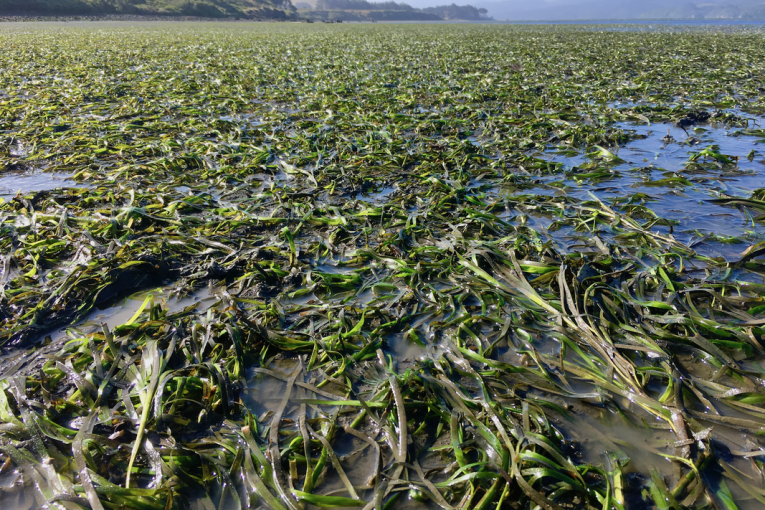

By Jolene Darensbourg
DAVIS – The Bodega Marine Laboratory finished their UC Davis fall seminar series on Wednesday with speaker Katie Dubois, who explained her studies on how the mechanisms of eelgrass are resilient to ocean warming by discussing the phenotypic diversity across space and time.
The ocean is warming and the frequency of marine heatwaves has been increasing – this is happening all over the world and is affecting the ecosystems.
The increasing number of marine heatwave days are positively correlated with more coral bleaching, loss of seagrass density and a decline in kelp biomass, which is becoming a big problem for our oceans. This problem led DuBois to come up with a question – what factors would determine species’ resilience to ocean warming?
One way to think about resilience and species is to refer to phenotypic variation within species.
Broken down into less scientific terms, a phenotype is an observable characteristic where an individual’s characteristics, such as the plant traits, respond to the heat warming.
DuBois explained that there are many different ways that phenotypic diversity can show resilience in species by the distribution of phenotypes in different populations that can affect the local adaptation, where phenotypes are matching their local thermal environment, or they can be distributed across all three environments through limited gene flow.
The diversity of phenotypes within a population respond to temperatures.
Some prefer intermediate temperatures while others prefer warmer temperatures, and the diverse population gets a portfolio effect where productivity is maintained across all temperature environments that can enhance ecosystem functions and diversity.
The individuals can also then demonstrate phenotypic plasticity, which is the ability of the individual to change their phenotype as the environment changes.
Eelgrass provides the foundation for habitats of the marine organisms in an ecosystem, but the unique aspect of eelgrass is that it is broadly distributed and can be found along the coastlines of the entire Northern Hemisphere.
DuBois’s work in Tomales Bay explores how phenotypic diversity can promote resilience in eelgrass in response to ocean warming across populations, within populations and at an individual level.
Eelgrass is a broadly distributed species, which is important because there is a dramatic shift in species distribution around the globe in response to warming, and there can be more trailing edge species located at the equator that are contracting while leading edge-cooling species are expanding.
Broadly distributed species are unlikely to have gene flow, from the trailing edge to the cooling leading-edge population, which makes it very unlikely for warming resilient phenotypes to spread through the populations.
However, DuBois mentioned that if you take into consideration local versus latitudinal gradients, such as the North American Pacific coast, the temperature ranges from 11 degrees Celsius to 21 degrees Celsius, and there can be potential for phenotypes to mix across populations.
At Tomales Bay, the temperatures match those of the coastline, providing an excellent research and testing site for local adaptation of eelgrass populations, and monitoring the warming differentiation impacts the population.
To start her experiments, DuBois and her team planted a three-way reciprocal transplant experiment that had 40 individuals from each population planted at each site that was to be grown in the field for one year, with monitoring every three months.
A single chute was planted and after the course of a year, they looked at the average chute count between the plots at all four sites, and they came to the conclusion that home site genotypes always outperform genotypes from outside populations, indicating that local adaptation on a smaller scale could be happening.
Temperature can also play a role in the population differentiation, and it potentially plays a role in the strong patterns of home site advantages found in their field experiments.
A single population of eelgrass traits was studied for over two years, and it was found that genotypes vary in response to warming.
The researchers measured growth measurements between hot and cold temperatures and noticed that the hot treatments had shifted from a hot, bright environment to a warm, dark environment and the cool treatments shifted from warm and bright to cold and dark.
The controlled temperature treatments were then used as a factor with the total pot biomass to find that there was a positive effect of diversity in the warming treatment.
The resilience of eelgrass within trans-generational phenotypic plasticity is a change in offspring phenotype by an environmental signal in the parent generation without involving a genetic change.
DuBois’s research on eelgrass and its resilience in ocean warming gave viewers more understanding of how phenotypes can be mixed into different populations, based on temperature.
Her research even demonstrated how the phenotypic plasticity can change when reflected by the environment.